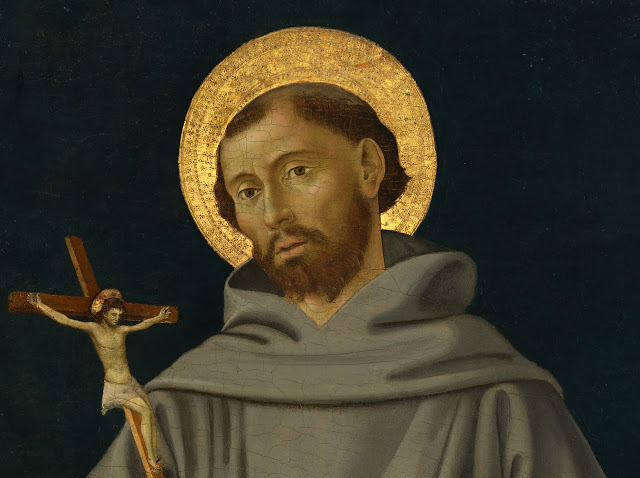Saint Francis by Benedetto Aquilio 1480
Depiction of Saint Francis of Assisi by Antonio di Benedetto Aquilio, commonly known as Antoniazzo Romano (Tempera on wood, 1480).
Antoniazzo was an Italian early Renaissance painter: a leading figure of the Roman school during the latter part of the 15th century. He was influenced at first by the decorative manner of Benozzo Gozzoli and Fra Angelico, as well as other local painters in the region of Lazio.
The earliest documented work dates from 1461, and it was a replica of Virgin and the Holy Child, in the Basilica of Santa Maria Maggiore of Rome. The work was requested by Alessandro Sforza.
From 1464 he worked for the papal court, producing pieces in Rieti dedicated to many Saints. He completed the decoration of a funerary chapel, frescoes in Monasteries, decoration of public rooms of the Palazzo Venezia, and ornaments for many other churches and chapels. He soon became a talented copier of religious icons.
Between 1475 and 1480, Antoniazzo delivered a considerable amount of altarpieces and panels dedicated to the Virgin. The trend was not a coincidence, but the result of the encouragement of the cult to the Virgin Mary by Pope Sixtus IV.
In 1480, Antoniazzo analyzed the work of Domenico Ghirlandaio, then engaged on the decorations of the Sistine chapel, and received prestigious commissions in the Vatican palace, to commemorate the Holy Year of 1500. Ghirlandaio’s influence originated that Antoniazzo’s figures acquired gentler expressions. Their garments became more ornamented with decorative patterns, but always maintaining several medieval features.
This imposing depiction of Saint Francis of Assisi was painted as one single panel for the Altar on Colonna's Chapel, in Santa Maria Maggiore, Tivoli. As attested by the coat-of-arms and inscription at the lower edge, the picture was requested by Clemente Brigante, who had a great devotion to Saint Francis. Brigante was member of the powerful Colonna family of Rome, but also a leading citizen of Tivoli, having being once its governor.
Saint Francis’ gaze seems to address the viewer. He is taller than what we know he was, wearing a dark grey habit, holding a tall crucifix in the right hand, and the Holy Scriptures covered in red, in the left hand.
His hands and feet show us the signs of stigmata, and its dark background, highlights the golden halo on the head of the saint. Such halo is made of sheets of gold, and the same technique was used in the halo of our Lord Jesus on the cross.





Comments
Post a Comment